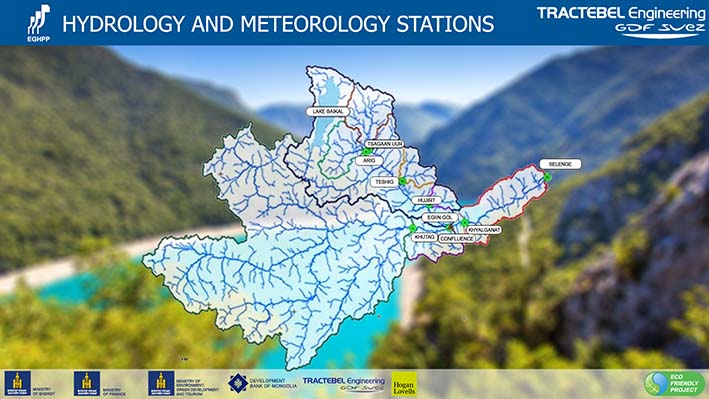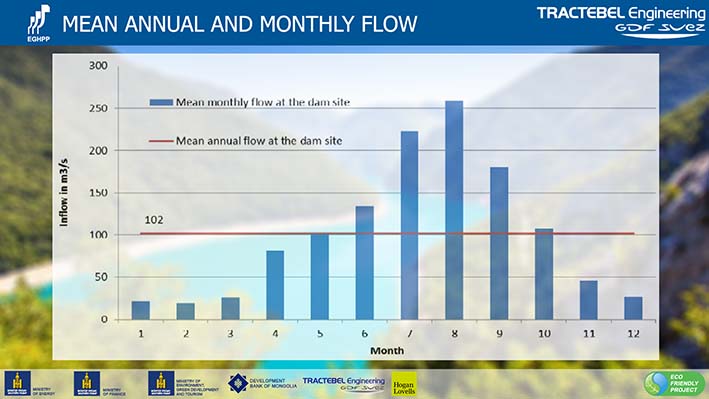- The operation of the EGHPP will contribute to the central energy system of Mongolia hence it will be independent from foreign countries.
- Egiin Goliin Hydro power plant will be the 1st high capacity hydro power plant in Mongolia.
- In 2015, total demand of electricity will exceed over supply.
- Egiin Goliin hydro power plant is one of the highly possible variation which can replace import of electricity.
- Central energy system of Mongolia imports annually $ 25 mln of electricity.
- Egiin Goliin hydro power plant will guarantee the national security of electricity.
- According to the geological study, the EGHPP geological condition of the dam foundation is found to be very agreeable.
- In November 2013, the Government of Mongolia passed resolution to start the construction of Egiin Goliin hydro power plant.
- Over the years total cost of the building power plant is increasing.
- The EGHPP is located at the confluence of Egiin and Selenge river 2.5km upstream.
- Construction of EGHPP will open opportunities of farming the water birds, fish and sable breeding.
- To fill the reservoir with water during summer and to generate electricity during winter.
- In the area of Egiin Goliin hydro power plant, annual precipitation is between 300 and 310 mm.
- In the area of Egiin Goliin hydro power plant, average temperature in December is -40 C, in July and August are +25 C.
- An ice phenomena of EGHPP, will be at its highest in December will reach 1.5m.
- In the area of Egiin Goliin hydro power plant, mean wind speed is 2.3 m/sec, humidity level is 72%.
- Since 1977, Mongolia paid $311 mln which equals to 451 bln of tugrugs on electricity imported from Russian Federation.
- Start up minutes of hydro power plant is 2-5 minutes in contrast to Thermal power plant 2-4 hours.
- Central energy system’s daily load during the winter is 776-800 MW.
- The EGHPP generated energy will be connected to the CES via 2 circuits double conductors with capacity of 220 kV.
- The main criteria for meeting the environmental objective are avoided of carbon dioxide (CO2) emissions, and the specific carbon offset of the project is determined in terms of carbon dioxide (CO2) emissions avoided per GWh over the lifetime of the project and thus EGHPP reduces 709 thousand ton of CO2 annually.
- By 2022,EGHPP is to produce 581 million kWh annually at minimum and the annual electricity generation is to vary between 581 to 2662 million kWh.
- By the April 2014 investigative study discovered 218 artifacts at the hydropower plant DAM SITE (910м), and 24 artifacts at the infrastructure route.
- 242 artifacts are planned to be excavated and preserved in 2014-2015.
- 423 species of plants grow at the Egiin Goliin DAM SITE.
- Hydropower costs less than most energy sources.
- Renewable Energy creates three-times more jobs than fossil fuels.
- In 1878 the world's first hydroelectric power scheme was developed at Cragside in Northumberland, England by William George Armstrong.
- Hydropower today provides about 20 % of the world's electricity and is the main energy source for more than 30 countries.
- Hydropower facilities can quickly go from zero power to maximum output, making them ideal for meeting sudden changes in demand for electricity.
- Hydropower can also be used for water supply, flood control, irrigation and even recreation purposes.
- The financial status of the hydroelectric industry is generally healthy due to long equipment life and low maintenance and operating costs.
- Egiin Goliin hydropower plant is estimated to cover the investment in 20-25 years of time with its sales income.
- Thermal power plants in UB city burns 3.5 million tons of raw coal, pollutes the air with 4 tons of coal, 4.5 million cubic meters of gas and 6kg emissions of sulfur gas.
- The Eg river is Mongolia's third largest river, and at the proposed dam site has a catchment area of about 40,000 km².
- Due to Mongolian country characteristics and situation, the value of 315 MW installed capacity has been selected.
- There are 21 types of fish at the Eg river.
- The new bridge that will be built across River Selenge will be a steel concrete bridge.
- Turbines and generators are expected to be replaced after 32 years of operation.
- Peak demand of the Mongolian energy system reached 948 MW, exceeding both installed and feasible generation capacity and the reason for increased imports of electricity
- Electricity is imported from Russia to the Central Region Integrated System via Selendum sub-station Russia and Darkhan sub-station Mongolia.
-
CONTRACTOR -
 TRACTEBEL ENGINEERING (GDF SUEZ) S.P.A
TRACTEBEL ENGINEERING (GDF SUEZ) S.P.ATractebel Engineering (GDF Suez) of France is working as a consulting company of the Egiin Goliin HPP. Tractebel Engineering is a business unit of GDF SUEZ Energy Services, the European leader in multi-technical energy related services and one of the key business lines of GDF SUEZ. Headquartered in Brussels (Belgium), and with offices in 33 countries and projects in over 140, Tractebel Engineering undeniably is a top-level partner for every single of its clients. Tractebel Engineering is a global engineering consultancy company with more than 100 years of expertise in energy and infrastructure projects. Tractebel Engineering employs around 4,400 people. Tractebel Engineering has undertaken around 650 dam engineering projects in over 70 countries worldwide. Of those studied, 250 dams have been built to date.
-
SUBCONTRACTOR -
 MONGOLIAN NATIONAL METEOROLOGY AND ENVIRONMENTAL MONITORING
MONGOLIAN NATIONAL METEOROLOGY AND ENVIRONMENTAL MONITORINGMeteorology and Environmental Monitoring is the Government Implementation Agency to store and protect information and documents of meteorology and environmental monitoring, and provide archival customer services. The Egiin Goliin hydropower plant project unit has been cooperating with this organization for collection, processing and analyzing meteorological and hydrological data of the Eg river basin, Khutag-Undur soum of the Bulgan province where the project is planned to be implemented.
-
Date: 2014.04.25 - 2014.08.25 -
BASIS -

Hydrology and meteorology data 1959-1991 of 32-years within the previous feasibility study was extended with data 1992-2013 of 21-years in order to process 54-years data and update Eg river’s flow estimation was necessary.
-
IMPORTANCE -

Reservoir operation assessment, dam site evaporation assessment, and rainfall series assessment were all completed using updated hydrology and meteorology data. The total inflow was reconstructed and assessed based on dam site flow, type of surface, rainfall ratio, and estimated flow in intermediate catchment area.
-
CONCLUSION -

Updated flow estimated at 102 m3/s, increasing from the previous flow estimation of 95 m3/s, after collecting and processing 1959-2013 meteorological data from National Agency for Meteorology and Environment Monitoring of Mongolia and 1959-2012 hydrological data from Hydrology, Meteorology Research Institute respectively and extending with 1992-2013 data of 21-years. Main hydrology estimation parameters are: previous flow estimation-95 m3/s, updated flow estimation-102 m3/s, probable maximum flood Q-9600 m3/s, and estimated flood discharge for 10 years-5720 m3/s.
DAM SITE
-
THE DAM SITE IS LOCATED
2.5 KM FROM THE CONFLUENCE OF THE EG-SELENGE river in KHUTAG-UNDUR SOUM, BULGAN PROVINCE.
RESERVOIR
-
NORMAL WATER LEVEL
910 M A.S.L -
VOLUME AT NORMAL WATER LEVEL
5.7 BILLION m3 -
SURFACE AREA
154.3 KM2
DAM
-
DAM CREST LEVEL
912 M A.S.L -
DAM CREST WIDTH
8 м -
DAM CREST LENGTH
740 M -
DAM HEIGHT ABOVE NATURAL GROUND
82 м -
DAM VOLUME
2.29 MILLION m3
POWER HOUSE
-
INSTALLED CAPACITY
315 МW -
ANNUAL ELECTRICITY PRODUCTION
606 MILLION KWh -
TURBINE
FRANCIS 4 X 68.78 MW, 2 X 20.5 MW, 1 X 3 MW
PROJECT INFRASTRUCTURE
-
FROM THE DAM SITE TO THE ERDENET SUBSTATION
72.3 KM DOUBLE CIRCUIT 220KV TRANSMISSION LINE -
FROM THE DAM SITE TO THE ERDENET CITY
71.9 KM ACCESS ROAD, 320 M LONG REINFORCED CONCRETE BRIDGE OVER THE SELENGE RIVER














